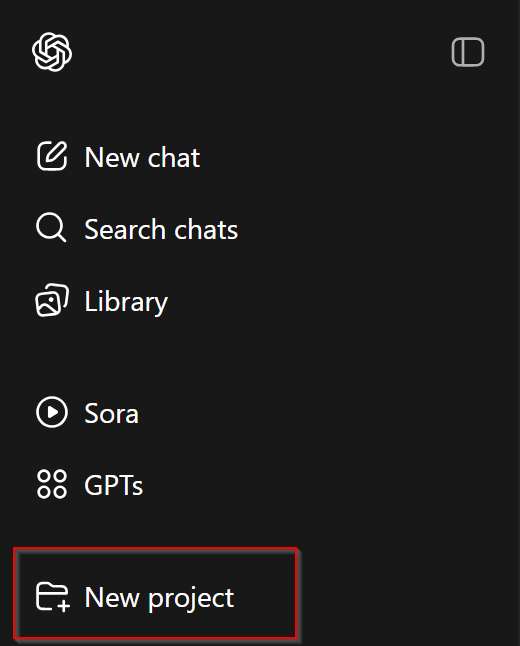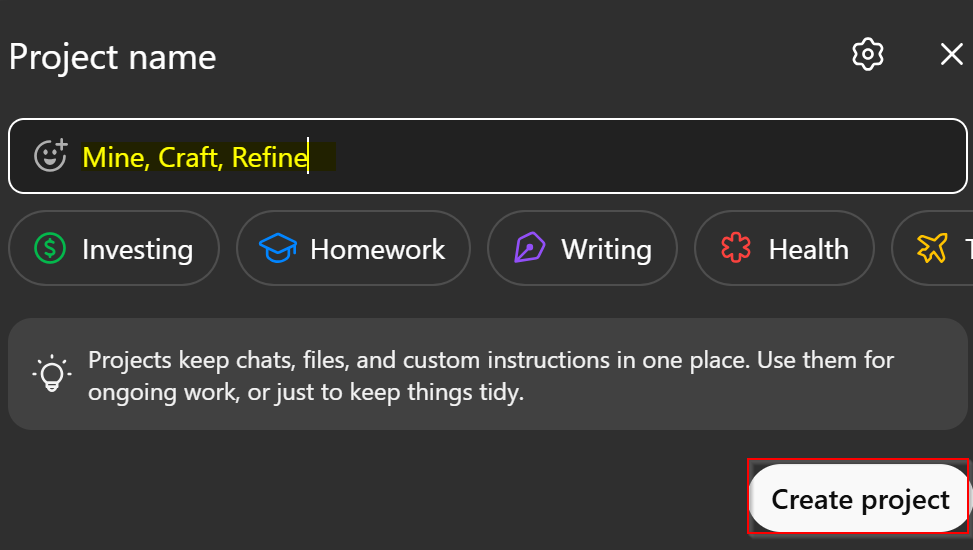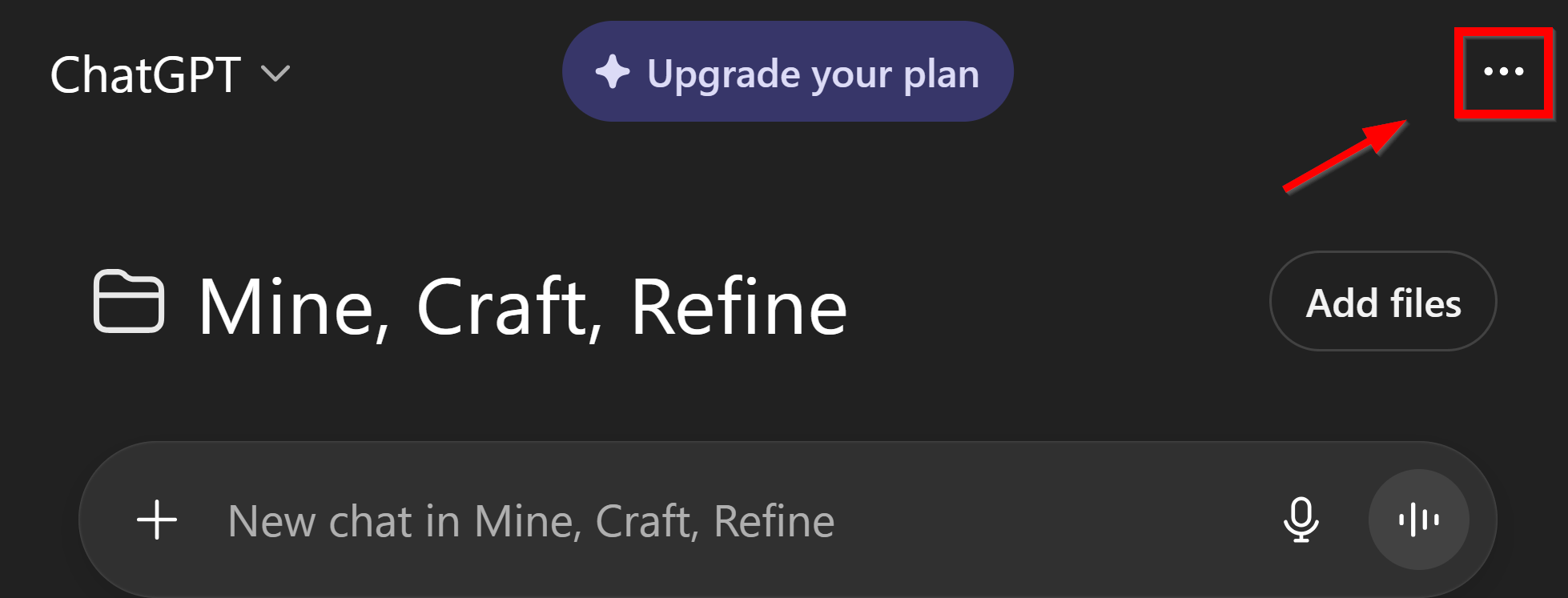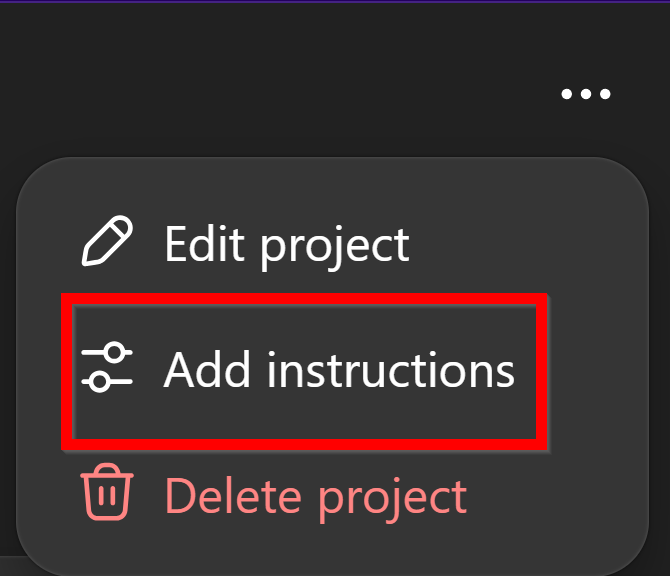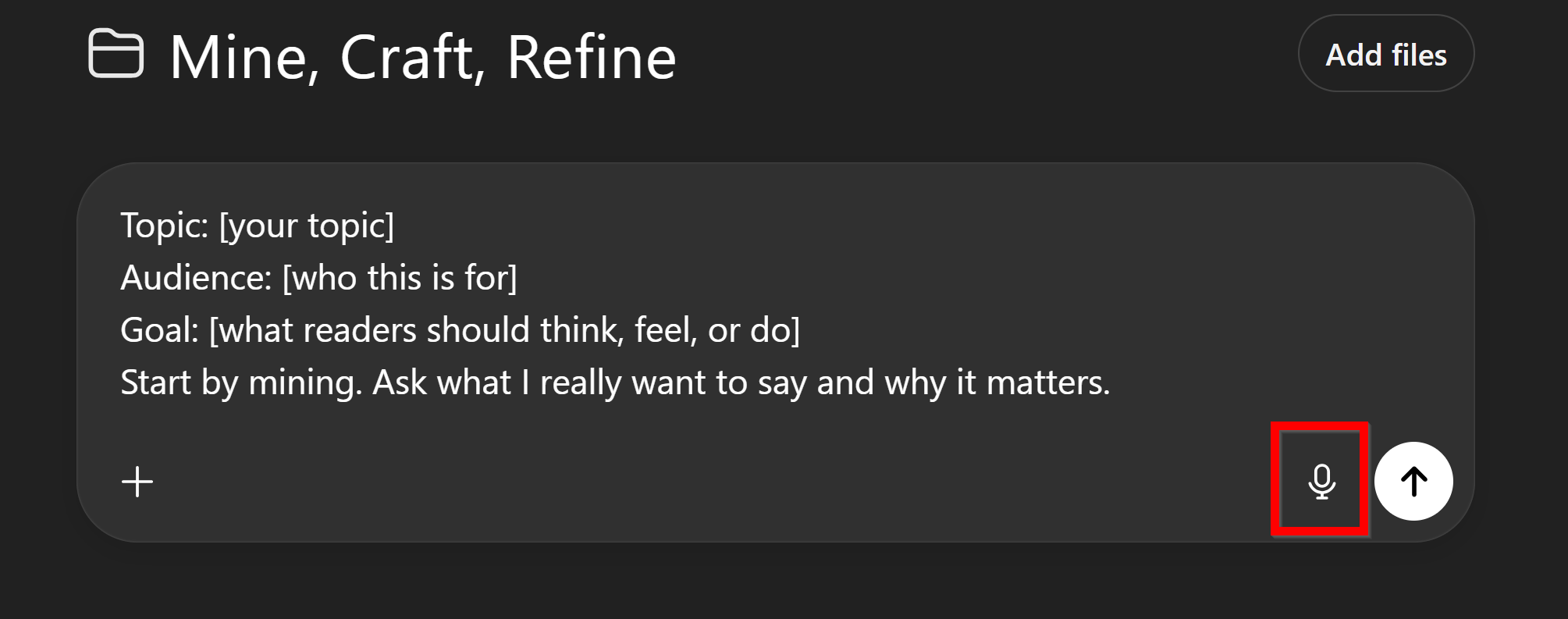Stop Overthinking, Start Using AI
Learn the simple loop I use to ship real work with AI. No endless tweaking.
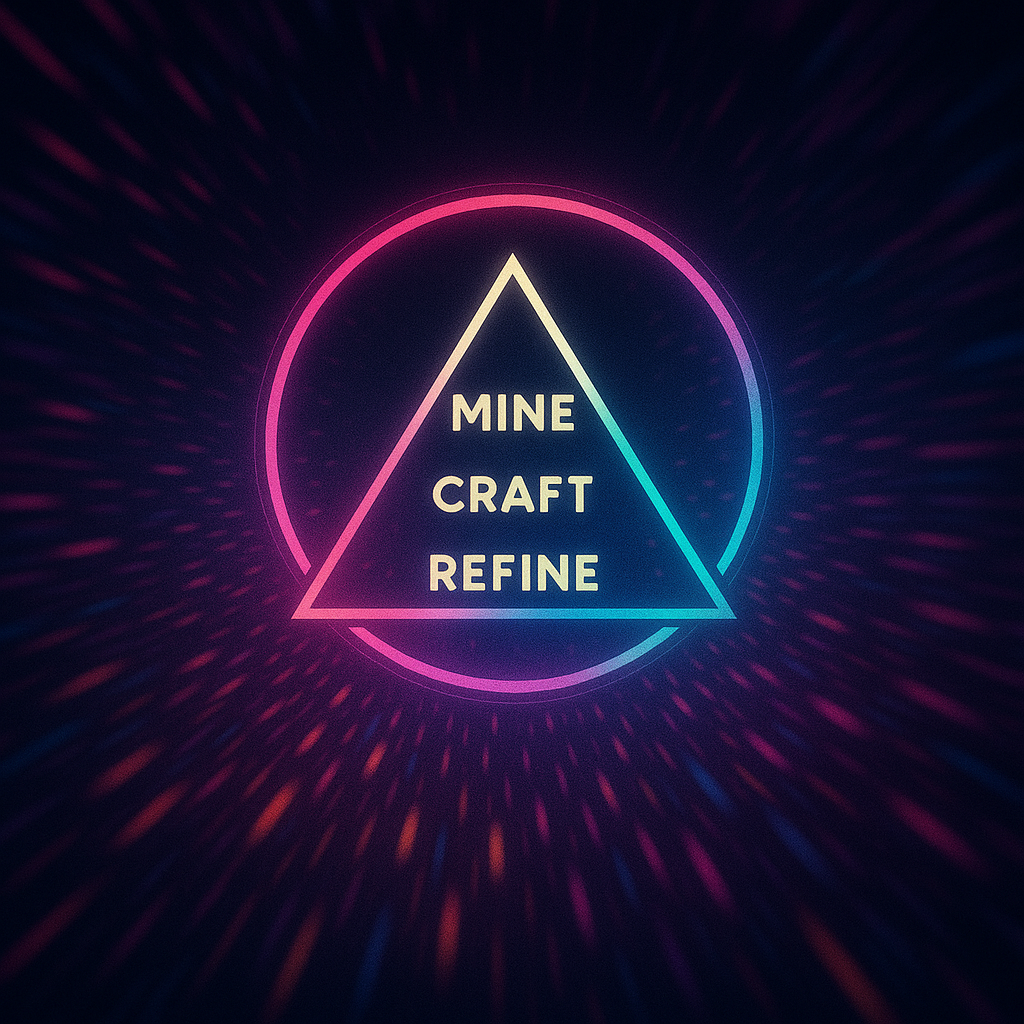
We've all heard it from both sides. AI is either humanity's greatest breakthrough or just super autocomplete. We're either thousands of days away from superintelligence or it's a bubble, it's all hype, and we've hit a wall. The arguments are everywhere. You don't need to solve that debate to get value today. You can start getting leverage in the next half hour.
While so many are confused, some people are quietly stepping into a new reality where more is possible than ever before. They are thinking better, learning more, and doing more than they ever have in their lives. The difference isn't secret access. It's a learnable way of collaborating you're about to discover. If you're here, you're ready to try it.
I work with AI every day. It has completely changed how I approach challenges and how I write, research, create, and solve problems.
Here's what no one tells you: if AI isn't already part of your life, it makes sense you don't yet see its full value. Your opinions are built on fragments: headlines, opinions, cringy videos... The overwhelm is real, and it becomes a comfortable reason to do nothing.
Meanwhile, you could be working with an intelligent collaborator to think through problems, create solutions, and pull off projects that normally live on the "I didn't even realize this was possible" pile.
Lock in with me. Let me show you how not to get left behind.
The real problem: You don't know what's possible
"We don't know what we don't know until we start looking."
It's exciting to go from initial impressions to discovering something new that changes you. This happened to me with guitar, games, books, and with AI.
So many people don't have powerful first experiences with AI because they treat it like super-Google. Type a prompt, get a response. If the response isn't incredible, they conclude AI isn't ready.
But the best results come when you work with AI like a collaborator. There's a real skill here. Learn it, and the value of your results changes. Ask it to "write a million-dollar business idea," you'll get junk. Share real context, direction, and guidance, and you get something you can actually use.
Some people are turning day-long tasks into half hours, shipping things they couldn't tackle alone, and creating better than they ever thought possible.
The gap isn't the tech. It's how you use it. Same instrument, different musician: one makes noise, the other makes music.
Let me show you what this looks like
Here's a real example from my life. The technical details don't matter as much as the process; this same collaborative thinking applies whether you're drafting a plan, preparing a tough email, or analyzing data. It started like this:
Me: Help me think this through. I have about 80 network devices. Each has 48 connections. I have the device names and addresses, but the connection labels are just comments and they're often wrong or missing. People move cables and don't update the label. I need to see what's actually on each connection. (Mine)
AI: That's 80 x 48, so 3,840 checks. Even at 7-10 minutes per device, that's roughly 9-13 hours of focused work, likely 2-4 workdays with interruptions. Walk me through how you do one device by hand, and tell me what you already have that can help. (Mine)
See that? The AI puts the scope in context. It's not just answering; it's thinking with me.
Me: Manual flow: connect to a device, list its connections, try each one, see what responds, and write it down. Sometimes I see the device name, sometimes an on-screen message, sometimes nothing. I have the device list, secure remote login (SSH), and I know the commands. (Mine)
AI: Let's start small. I'll sketch a tiny test script (a "dry run" that doesn't touch real hardware) so we can check the flow. Then we'll try one real connection. (Craft)
AI (pushback): One thought before we scale. Is this the right long-term fix? Automating the cleanup helps now, but this keeps happening until the labeling process changes. (Mine)
Me: Fair point for phase two. Right now I need an accurate inventory. Let's build the tester. (Craft)
...we worked for a bit...
AI: The tester looks good. Next, let's try a real connection. We'll log exactly what comes back and write a short summary so it's readable later. Do you have a few devices we can test with? Also, I'll need your login credentials, but we should store them safely. I'll create a simple .env file so you can add the username and password there, and the script can read them without exposing them. (Craft -> Refine)Me: Sounds good. I filled out the .env file with my credentials. Also, here's a list of lab devices we can test. Let's run a batch of two. (Craft)AI: Got it. We'll try two first. Add timeouts and retries, keep an "unknowns" list, and make the log easy to skim with clear status markers. (Refine)
...we iterated...
AI: Ready to scale. We can run 20 devices at a time. You choose how many to run together, set credentials, and pick where results save. We'll write a CSV file and a short human summary. Devices that are unreachable get flagged for follow-up. (Refine)
About two and a half hours later, we had a tool that runs groups of 20 at once. The job that used to take 12 hours now finishes in 12 minutes. I can rerun it whenever I need fresh inventory.
Clear target, real context, quick back-and-forth, then shipping something that actually solves the problem. That's the collaboration that matters.
You might not be managing network connections, but you're definitely managing something: a marketing campaign, a complex process document, a quarterly budget.
The process is the same:
- break down the messy reality
- build a first draft solution,
- refine it into something that works.
We will be digging deeper into a framework that will help you get better results next.
If my example sounds like an outlier, look at the curve the tools themselves have been on.
From unreliable to powerful
You may be wondering why you should start learning to work with AI now. Here is why: when ChatGPT launched in November 2022, it felt like magic to me, but it wasn't reliable for complex work. Model capabilities are now dramatically better than they were then.
Today the shift is measurable:
PhD-level science (GPQA Diamond). A benchmark designed to challenge PhD scientists with graduate-level physics, chemistry, and biology that requires reasoning, not recall. Early ChatGPT managed ~39%. Human PhDs score ~74%. Current models like OpenAI's GPT-5 Pro hit 89.4%.
- What it tests: Graduate-level physics, chemistry, and biology that require multi-step reasoning across disciplines.
- Why it matters: Human PhDs average ~74%. 89.4% means the model is surpassing typical PhD-level performance on this set, signaling real scientific reasoning, not recall.
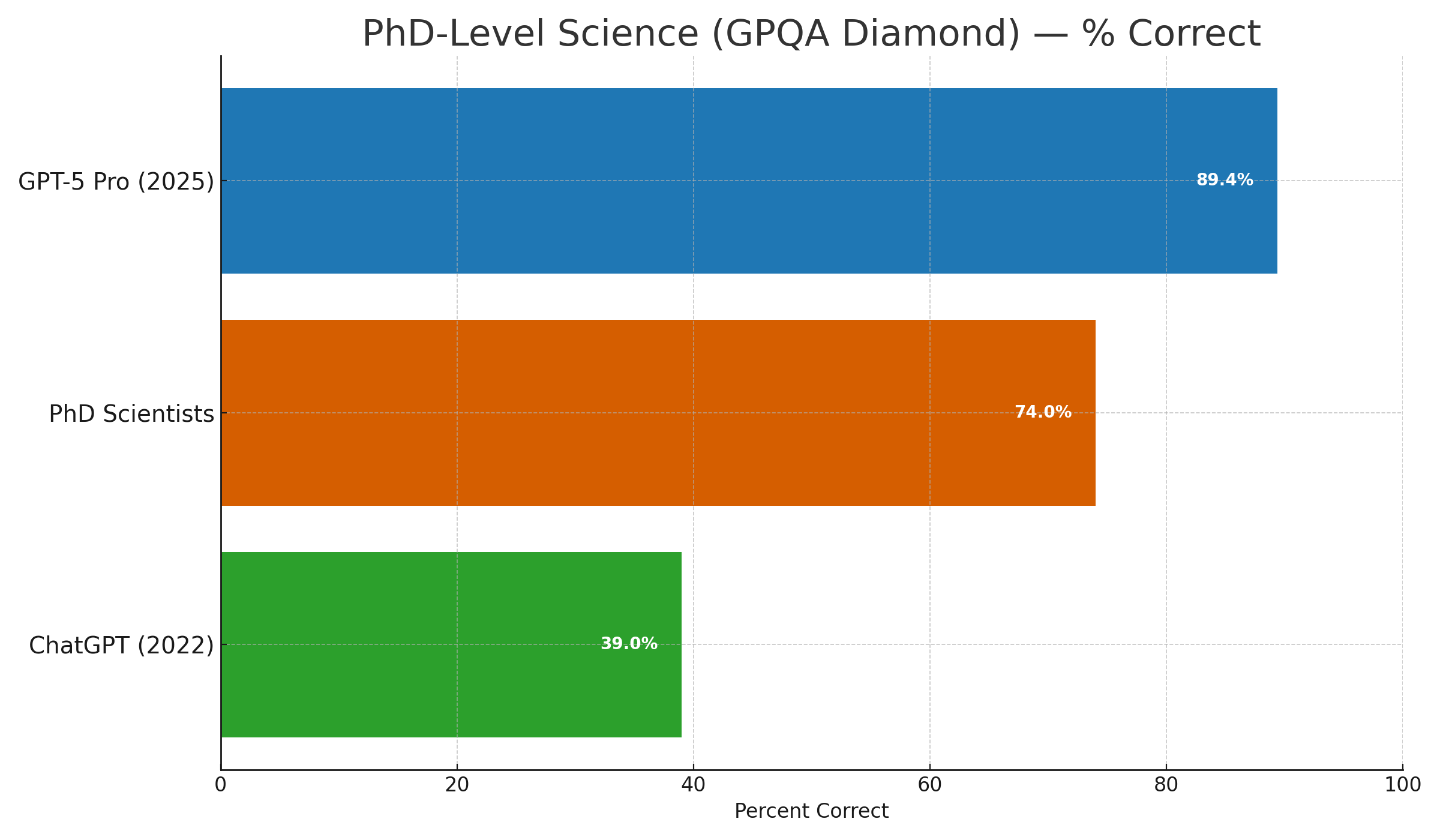
What does 89% on PhD-level science mean for you? It means AI can now reliably help with complex analysis, research synthesis, and technical problem-solving without hallucinating facts or missing critical connections.
Real bug fixing (SWE-bench Verified). Real GitHub issues from actual codebases that human engineers have solved. Early models struggled. New models like GPT-5 now match working engineers with score of 74.9% on this task.
- What it tests: Real repo bugs with exact versions; patch must compile and pass the project's tests to count.
- Why it matters: This maps to day-to-day engineering. ~74.9% implies many routine fixes can be drafted or closed end-to-end.
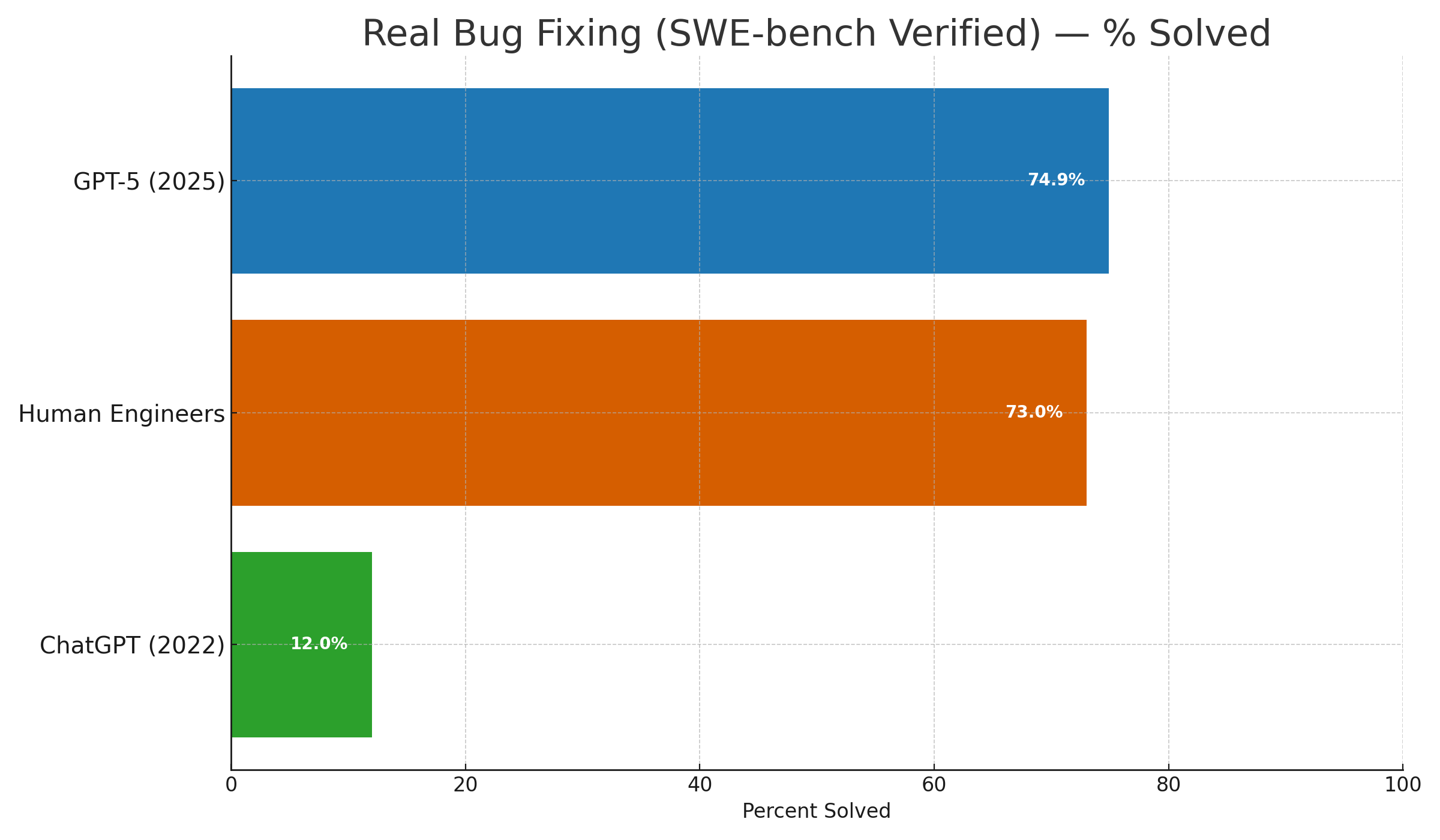
Two years ago, AI would introduce bugs while "helping" with code. Today it catches errors experienced developers miss and can handle entire workflows end-to-end.
Competitive programming (Codeforces). Algorithmic puzzles that separate casual coders from the elite. OpenAI o3 has reported a ~2716 Elo (top 0.2% globally; roughly international grandmaster level).
- What it tests: Unseen algorithmic problems in live contests with penalties and rating against top humans.
- Why it matters: ~2716 is top 0.2% (International Grandmaster range), showing consistent correctness under time pressure.
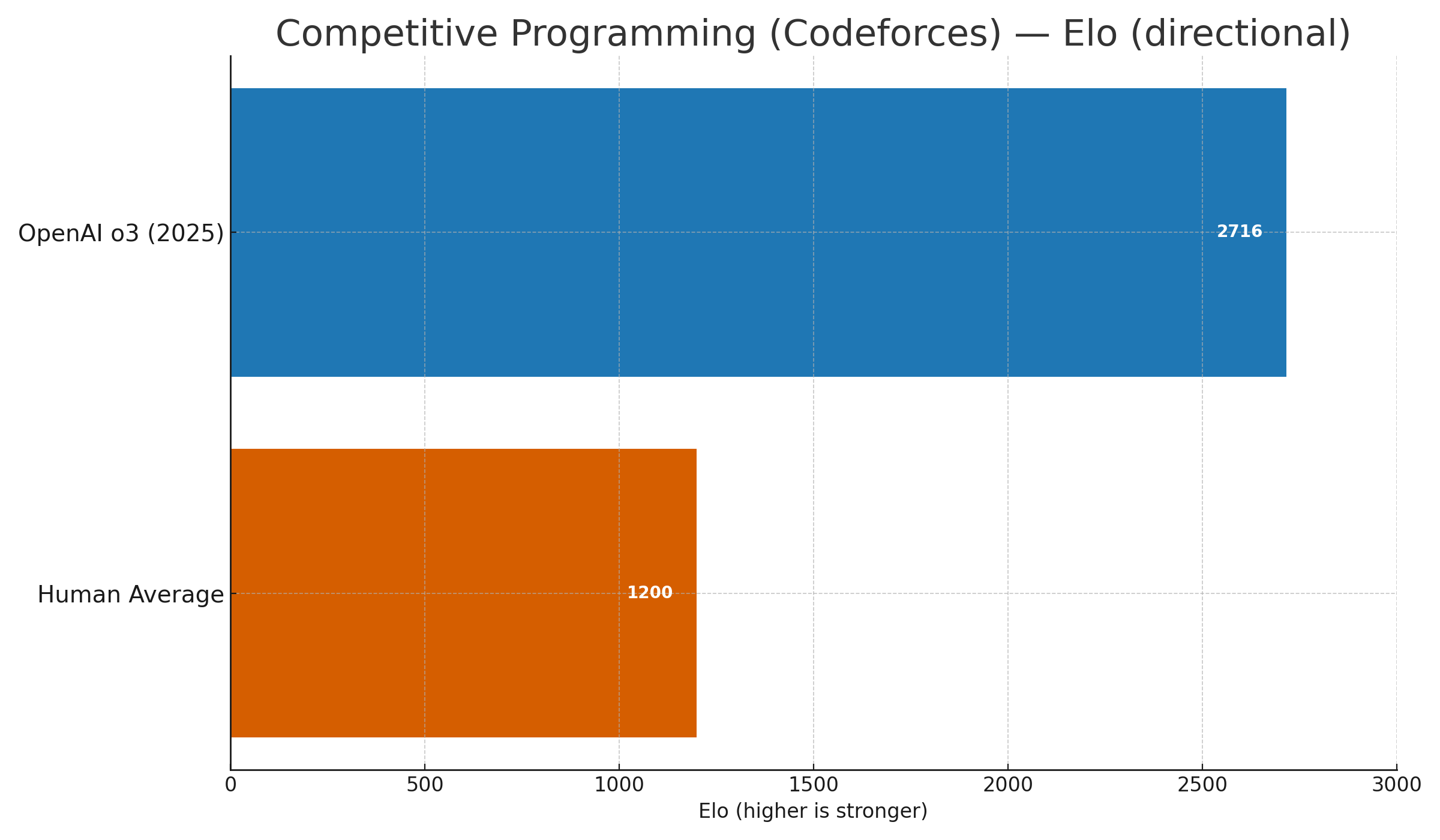
For non-programmers: This level of logical reasoning translates directly to business analysis, strategic planning, and complex problem solving in any field.
International Mathematical Olympiad (IMO 2025). Under official rules and timing, Gemini "Deep Think" and an OpenAI experimental model each scored 35/42, which is gold-medal level.
- What it tests: Two 4.5-hour written exams with six proof problems, graded 0-7 per problem.
- Why it matters: 35/42 reaches the gold band (roughly top 8-10%), demonstrating formal proof construction under strict exam rules.
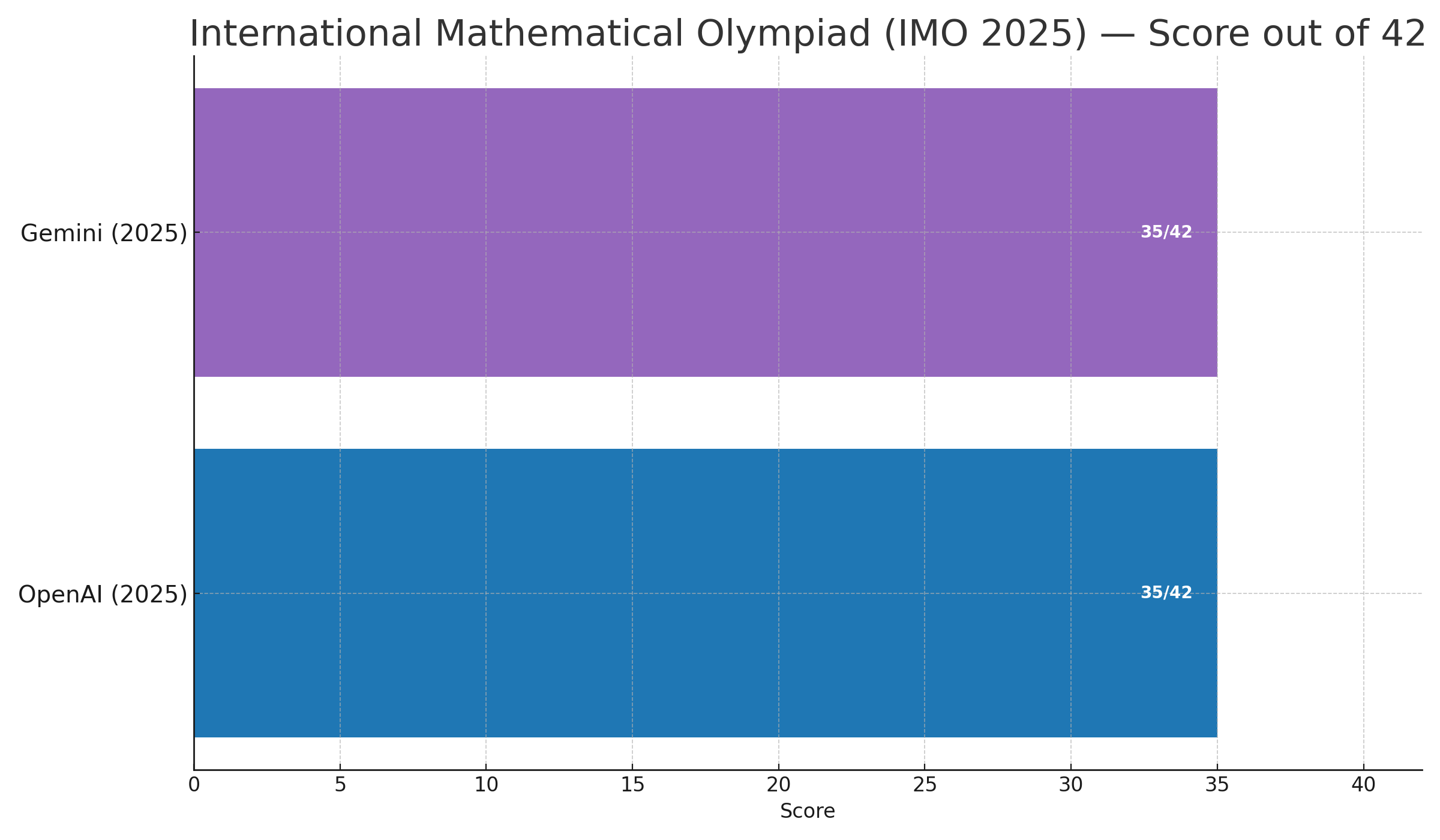
International Collegiate Programming Contest (ICPC) World Finals (2025). Under ICPC World Finals constraints, OpenAI's model solved 12/12 problems within the 5-hour window; Gemini 2.5 "Deep Think" solved 10/12, including a problem no human team solved. Both are gold-medal level performances.
- What it tests: Five-hour team programming with official judges, hidden datasets, and penalty rules.
- Why it matters: 12/12 (OpenAI) and 10/12 with a no-human-solved problem (Gemini) indicate podium-level performance under world-finals constraints.
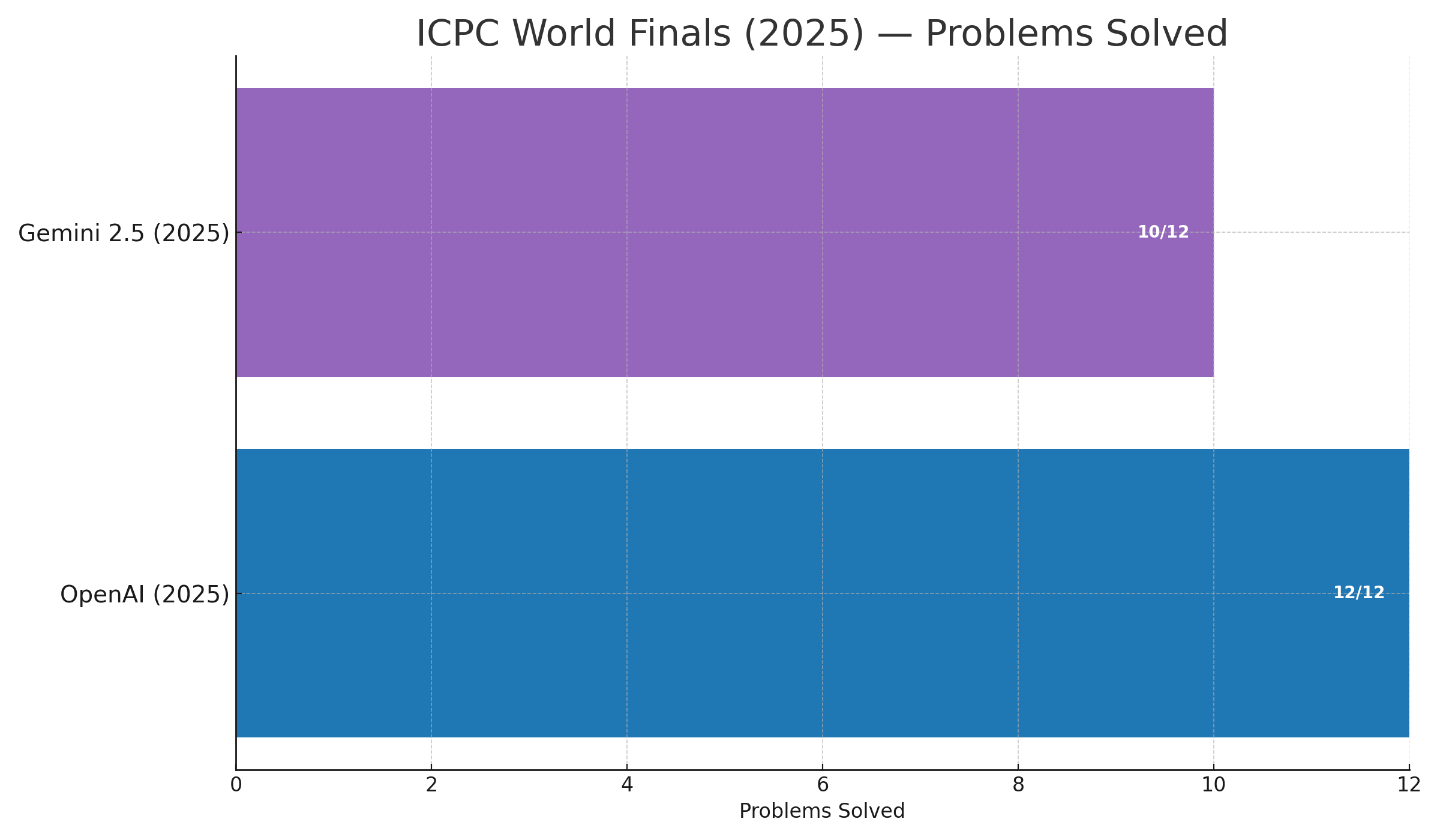
The pattern is clear: tasks that required deep expertise two years ago are now handled reliably by AI. Not because it memorized more facts, but because it learned to reason, verify, and solve problems systematically.
These aren't trivial capability improvements. They become real leverage. Now is the best time to start diving into AI collaboration because there is still a learning curve for getting the best results with them, and the models are more capable than ever.
Like turning 12 hours of work into 12 minutes.
Not every task will see that dramatic a shift, especially messy human work. But the repetitive thought work eating your time? Fair game. The creative project you've been putting off? The complex analysis you need? The technical solution you couldn't build alone? All possible when you know how to collaborate.
You provide the vision, judgment, and direction. The AI amplifies your capabilities.
The framework: Mine, Craft, Refine
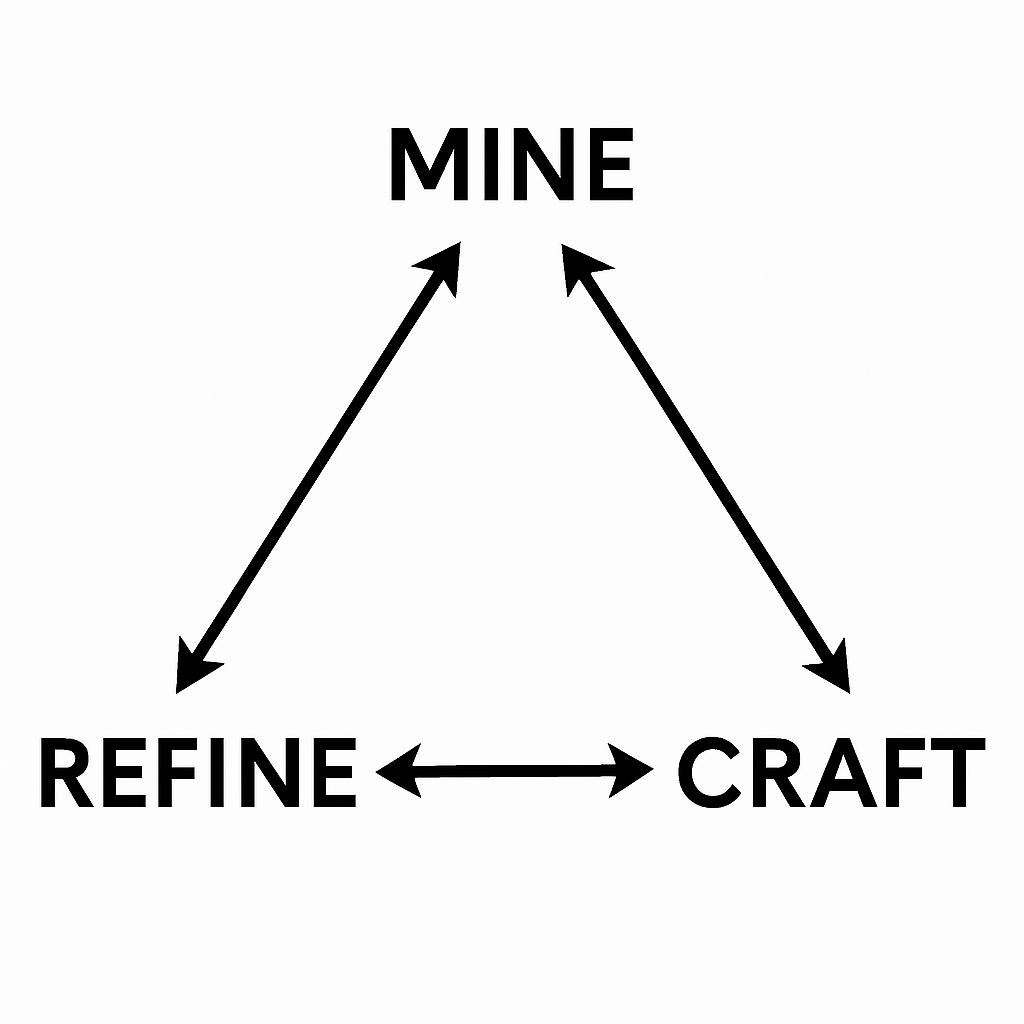
Now that you've seen what's possible with current model capabilities, here's the exact framework you can use to unlock powerful results for yourself.
This can feel like magic, but it isn't. It's something you probably already do, but made clear through the lens of a framework and applied with an intelligent partner that moves fast.
Mine: Surface shared understanding. Quantify scope. Expose assumptions, constraints, unknowns. Research where needed. Gather what you already have. Ask sharp questions until the problem or work comes into focus for you and the AI.
Craft: Build whatever makes sense next. Not perfect, just functional. An outline that becomes a draft. A sketch that becomes code. Keep the progress moving forward.
Refine: Make it better. Handle edge cases. Verify claims and numbers. Polish the rough edges. Increase efficiency. Ship something you can use today.
You'll bounce between these modes. Think of them as the corners of a triangle you can move between in any direction. Need clarity? Mine. Ready to create? Craft. Ready to improve? Refine.
Your activation (30 minutes)
Enough theory. Time to experience it.
Step 1: Pick ONE thing
- Write something real: an email, post, or document you actually need.
- Research something valuable: answers to questions you actually have.
Step 2: Pick your AI
Use what you have access to: Claude, Perplexity, or others. If you want to keep it easy, use ChatGPT. It's well-known for a reason: it's a great product and free accounts work fine to start.
If you don't have a ChatGPT account yet:
- Go to https://chatgpt.com/ and click Sign up
- Create your free account with email or Google/Microsoft login
- Verify your email if prompted: you're ready to go, no payment required
Step 3: Set up your workspace (2 minutes)
Before jumping in, create a dedicated ChatGPT Project for this collaboration. This keeps your AI thinking partner organized and remembers how to work with you.
- In the left sidebar, find Projects
Now add the framework as project instructions (applies to every conversation in this project):
You are my collaborative thinking partner. We will work in a loop: Mine, Craft, Refine.
MINE: Surface what's true. Ask clarifying questions. Quantify scope. Expose assumptions, constraints, unknowns, and risks. Research where needed. Gather assets I already have.
CRAFT: Build an end-to-end first version that works. Outline, then create. If coding, show a plan, then write it with simple run steps. If writing, outline, then a complete first pass in my voice. If research, a one-page brief with sources.
REFINE: Tighten and improve. Handle edge cases. Verify claims and numbers. Improve wording or user experience. Make sure the result matches the goal. Aim for ready to use.
Operating rules:
- Keep responses conversational and concise
- Always provide a clear next step
- Ask instead of assuming when unsure
- Focus on shipping something realStep 4: Add your prompt to the chat and send it
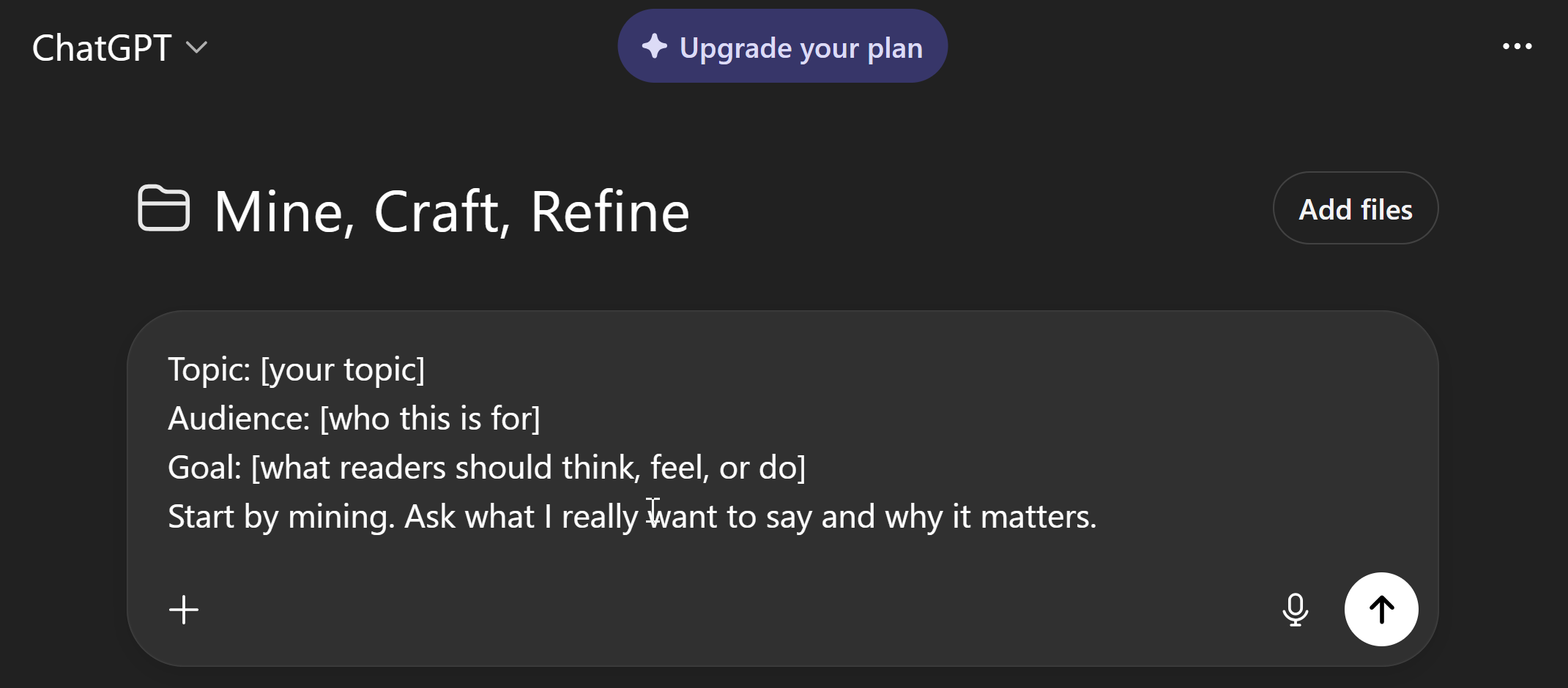
For writing:
Topic: [your topic]
Audience: [who this is for]
Goal: [what readers should think, feel, or do]
Start by mining. Ask what I really want to say and why it matters.For research:
Topic: [what I need to understand]
Decision: [what this will inform]
Questions I need answered: [list them]
Start by mining. Ask and clarify what I want to know and understand.Now, work with your AI of choice as if you were working with a coworker and see what you get.
The honest expectation
Getting the most powerful results with AI is a skill. The project setup helps, but results depend on how well you surface context, stay focused, and guide the work.
Like learning to play your first chord on the guitar, you're taking the first step. The shift happens when you stop prompting and start partnering. When you need to understand, create, or decide something, you'll Mine, Craft, and Refine by default.
Three things that actually help:
Here are three powerful questions to help you get the most from your work with AI:
- What questions can I answer or information can I provide that will help make this better and clearer?
- Does this make sense? Share your understanding and tell me what you think.
- Look at this as if you are on the line and this is your deliverable. What would you do next?
If you've made it this far and haven't tried it yet, do it now. Tomorrow never comes.
After 30 minutes, you'll have started your journey to more valuable results with your AI collaborations.
While everyone else is still sitting on the bench, you're creating and solving problems.
Pick one thing and start now.
You know what's possible now.
What will you do with it?
Verify the Numbers
For anyone wanting to dive deeper into the benchmarks I mentioned:
- GPQA Diamond results: GPQA paper (arXiv)
- SWE-bench Verified (GPT-5): OpenAI: Introducing GPT-5 for developers (74.9%)
- Benchmarks roundup: Vellum: GPT-5 Benchmarks
- Context on recent updates: Ahmed Azeem: Recent AI Model Updates That Actually Matter
- IMO 2025 gold-level: DeepMind: Advanced Gemini achieves gold-medal level at IMO - OpenAI and DeepMind reach IMO gold-level
- ICPC 2025 gold-level: DeepMind: Gemini 2.5 Deep Think at ICPC World Finals - OpenAI achieve gold at 'coding Olympics' - Ars Technica: Gemini solves problem no human team solved
- Primary receipts (social): Mostafa Rohaninejad on X - Alexander Wei on X
